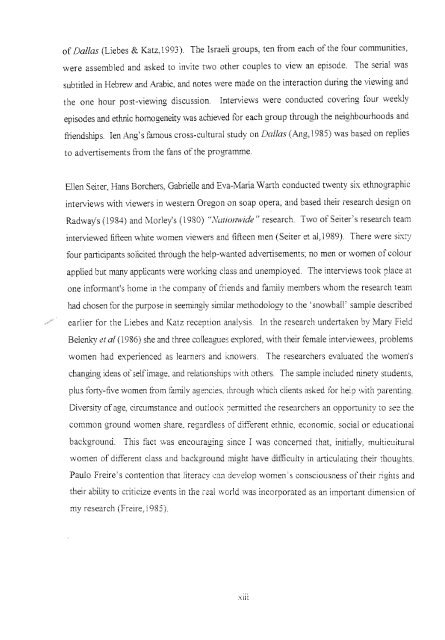View/Open - ResearchSpace
View/Open - ResearchSpace
View/Open - ResearchSpace
Create successful ePaper yourself
Turn your PDF publications into a flip-book with our unique Google optimized e-Paper software.
of Dallas (Liebes & Katz, 1993). The Israeli groups, ten from each of the four communities,<br />
were assembled and asked to invite two other couples to view an episode. The serial was<br />
subtitled in Hebrew and Arabic, and notes were made on the interaction during the viewing and<br />
the one hour post-viewing discussion. Interviews were conducted covering four weekly<br />
episodes and ethnic homogeneity was achieved for each group through the neighbourhoods and<br />
friendships. len Ang's famous cross-cultural study on Dallas (Ang, 1985) was based on replies<br />
to advertisements from the fans of the programme.<br />
Ellen Seiter, Hans Borchers, Gabrielle and Eva-Maria Warth conducted twenty six ethnographic<br />
interviews with viewers in western Oregon on soap opera, and based their research design on<br />
Radway's (1984) and Morley's (1980) "Nationwide" research. Two of Seiter' s research team<br />
interviewed fifteen white women viewers and fifteen men (Seiter et al,1989). There were sixty<br />
four participants solicited through the help-wanted advertisements; no men or women of colour<br />
applied but many applicants were working class and unemployed. The interviews took place at<br />
one informant's home in the company of friends and family members whom the research team<br />
had chosen for the purpose in seemingly similar methodology to the ' snowball' sample described<br />
,/. earlier for the Liebes and Katz reception analysis. In the research undertaken by Mary Field<br />
Beienk'Y et at (1986) she and three colleagues explored, with their female interviewees, problems<br />
women had experienced as learners and knowers. The researchers evaluated the women's<br />
changing ideas of self image, and relationships with others. Tne sample included niIlety students,<br />
plus forty-five women from family agencies, through which clients asked for help with parenting.<br />
Diversity of age, circumstance and outlook permitted the researchers an opportunity to see the<br />
corr.mon ground women share, regardless of different ethnic, economic, social or educational<br />
background. This tact was encouraging since I was concerned that, initially, multicuiturai<br />
women of different class and background might have difficulty in articulating their thoughts.<br />
Paulo Freire's contention that literacy can develop women's consciousness of their rights and<br />
tlleir ability to criticize events in the real world was incorporated as an important dimension of<br />
my research (Freire, 1985).<br />
Xlll

















